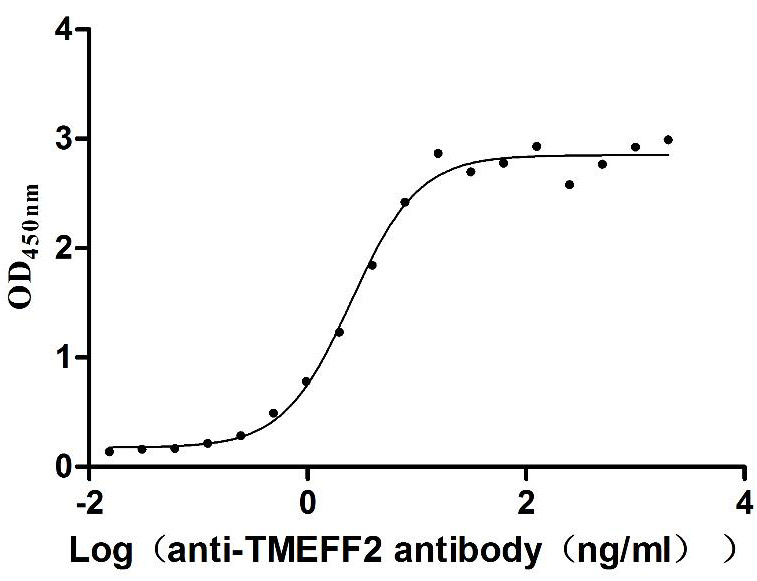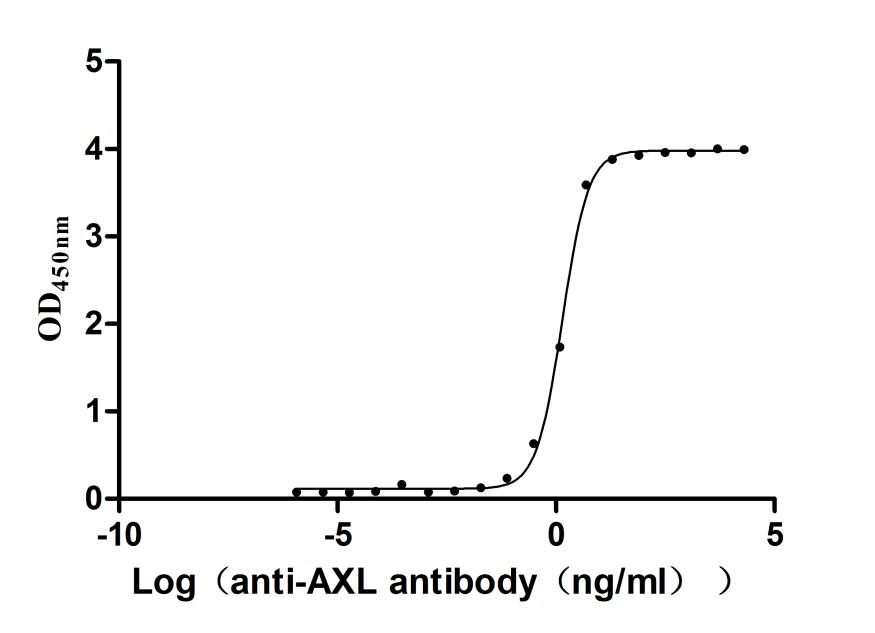Recombinant Human Ubiquitin-like-conjugating enzyme ATG3 (ATG3)
-
中文名稱:Recombinant Human Ubiquitin-like-conjugating enzyme ATG3(ATG3),Yeast
-
貨號:CSB-YP889107HU
-
規(guī)格:
-
來源:Yeast
-
其他:
-
中文名稱:Recombinant Human Ubiquitin-like-conjugating enzyme ATG3(ATG3),Yeast
-
貨號:CSB-EP889107HU
-
規(guī)格:
-
來源:E.coli
-
其他:
-
中文名稱:Recombinant Human Ubiquitin-like-conjugating enzyme ATG3(ATG3),Yeast
-
貨號:CSB-EP889107HU-B
-
規(guī)格:
-
來源:E.coli
-
共軛:Avi-tag Biotinylated
E. coli biotin ligase (BirA) is highly specific in covalently attaching biotin to the 15 amino acid AviTag peptide. This recombinant protein was biotinylated in vivo by AviTag-BirA technology, which method is BriA catalyzes amide linkage between the biotin and the specific lysine of the AviTag.
-
其他:
-
中文名稱:Recombinant Human Ubiquitin-like-conjugating enzyme ATG3(ATG3),Yeast
-
貨號:CSB-BP889107HU
-
規(guī)格:
-
來源:Baculovirus
-
其他:
-
中文名稱:Recombinant Human Ubiquitin-like-conjugating enzyme ATG3(ATG3),Yeast
-
貨號:CSB-MP889107HU
-
規(guī)格:
-
來源:Mammalian cell
-
其他:
產(chǎn)品詳情
-
純度:>85% (SDS-PAGE)
-
基因名:
-
Uniprot No.:
-
別名:2610016C12Rik; Apg 3; APG3; APG3 autophagy 3 like; APG3 like; APG3, S. cerevisiae, homolog of; APG3-like; APG3L; Apg3p; ATG 3; ATG3; ATG3 autophagy related 3 homolog; ATG3 autophagy related 3 homolog (S. cerevisiae); ATG3_HUMAN; Autophagy 3, S. cerevisiae, homolog of; Autophagy Apg3p/Aut1p like; autophagy related 3; Autophagy related protein 3; Autophagy-related protein 3; DKFZp564M1178; FLJ22125; hApg3; MGC15201; OTTHUMP00000214547; OTTHUMP00000214548; PC3 96; Protein PC3-96; Ubiquitin-like-conjugating enzyme ATG3
-
種屬:Homo sapiens (Human)
-
蛋白長度:full length protein
-
表達區(qū)域:1-314
-
氨基酸序列MQNVINTVKG KALEVAEYLT PVLKESKFKE TGVITPEEFV AAGDHLVHHC PTWQWATGEE LKVKAYLPTG KQFLVTKNVP CYKRCKQMEY SDELEAIIEE DDGDGGWVDT YHNTGITGIT EAVKEITLEN KDNIRLQDCS ALCEEEEDED EGEAADMEEY EESGLLETDE ATLDTRKIVE ACKAKTDAGG EDAILQTRTY DLYITYDKYY QTPRLWLFGY DEQRQPLTVE HMYEDISQDH VKKTVTIENH PHLPPPPMCS VHPCRHAEVM KKIIETVAEG GGELGVHMYL LIFLKFVQAV IPTIEYDYTR HFTM
-
蛋白標(biāo)簽:Tag?type?will?be?determined?during?the?manufacturing?process.
The tag type will be determined during production process. If you have specified tag type, please tell us and we will develop the specified tag preferentially. -
產(chǎn)品提供形式:Lyophilized powder
Note: We will preferentially ship the format that we have in stock, however, if you have any special requirement for the format, please remark your requirement when placing the order, we will prepare according to your demand. -
復(fù)溶:We recommend that this vial be briefly centrifuged prior to opening to bring the contents to the bottom. Please reconstitute protein in deionized sterile water to a concentration of 0.1-1.0 mg/mL.We recommend to add 5-50% of glycerol (final concentration) and aliquot for long-term storage at -20℃/-80℃. Our default final concentration of glycerol is 50%. Customers could use it as reference.
-
儲存條件:Store at -20°C/-80°C upon receipt, aliquoting is necessary for mutiple use. Avoid repeated freeze-thaw cycles.
-
保質(zhì)期:The shelf life is related to many factors, storage state, buffer ingredients, storage temperature and the stability of the protein itself.
Generally, the shelf life of liquid form is 6 months at -20°C/-80°C. The shelf life of lyophilized form is 12 months at -20°C/-80°C. -
貨期:Delivery time may differ from different purchasing way or location, please kindly consult your local distributors for specific delivery time.Note: All of our proteins are default shipped with normal blue ice packs, if you request to ship with dry ice, please communicate with us in advance and extra fees will be charged.
-
注意事項:Repeated freezing and thawing is not recommended. Store working aliquots at 4°C for up to one week.
-
Datasheet :Please contact us to get it.
相關(guān)產(chǎn)品
靶點詳情
-
功能:E2 conjugating enzyme required for the cytoplasm to vacuole transport (Cvt), autophagy, and mitochondrial homeostasis. Responsible for the E2-like covalent binding of phosphatidylethanolamine to the C-terminal Gly of ATG8-like proteins (GABARAP, GABARAPL1, GABARAPL2 or MAP1LC3A). The ATG12-ATG5 conjugate plays a role of an E3 and promotes the transfer of ATG8-like proteins from ATG3 to phosphatidylethanolamine (PE). This step is required for the membrane association of ATG8-like proteins. The formation of the ATG8-phosphatidylethanolamine conjugates is essential for autophagy and for the cytoplasm to vacuole transport (Cvt). Preferred substrate is MAP1LC3A. Also acts as an autocatalytic E2-like enzyme, catalyzing the conjugation of ATG12 to itself, ATG12 conjugation to ATG3 playing a role in mitochondrial homeostasis but not in autophagy. ATG7 (E1-like enzyme) facilitates this reaction by forming an E1-E2 complex with ATG3. Promotes primary ciliogenesis by removing OFD1 from centriolar satellites via the autophagic pathway.
-
基因功能參考文獻:
- ATG3 was targeted by miR-23a, suggesting that ATG3 is an autophagy-related competing endogenous RNA. PMID: 30007957
- Results revealed that miR-16 was significantly downregulated, and ATG3 was significantly upregulated in non-small cell lung carcinoma (NSCLC) patient tissue samples. ATG3 was found to be a direct target of miR-16. PMID: 29138833
- miR-155 silencing rescued autophagosome number in Mycobacterium tuberculosis infected dendritic cells and enhanced autolysosome fusion, thereby supporting a previously unidentified role of the miR-155 as inhibitor of ATG3 expression. PMID: 29300789
- PTK2 inhibition-induced sustained levels of ATG3 were able to sensitize cancer cells to DNA-damaging agents. PMID: 28103122
- Our data demonstrate that HOTAIR promotes the activation of autophagy in HCC cells by upregulating the expression of the autophagy-related genes ATG3 and ATG7. PMID: 27301338
- ATG3 upregulation contributes to autophagy induced by the detachment of intestinal epithelial cells from the extracellular matrix, but promotes autophagy-independent apoptosis of the attached cells PMID: 26061804
- Hidden Markov models were used to detect protein homology among the flexible regions of Atg3 homologs and importance of conserved regions evaluated by performing affinity capture experiments with human Atg3 deletion constructs; binding studies and competition experiments demonstrate that overlapping sites in the Atg3FR are important for E3 binding and E1 binding. PMID: 24186333
- The region of human ATG3 that interacts with ATG7 is precisely identified using nuclear magnetic resonance. PMID: 26043688
- ATG3 gene and its gene family may play an important role in transformation of myelodysplastic syndrome. PMID: 24420857
- Lipidation of the LC3/GABARAP family of autophagy proteins relies on a membrane-curvature-sensing domain in Atg3. PMID: 24747438
- 13 residues of the ATG3 fragment form a short beta-strand followed by an alpha-helix on a surface area that is an exclusive binding site for ATG12. PMID: 24191030
- caspase-8 overexpression led to Atg3 degradation and this event depended on caspase-8 enzymatic activity PMID: 22644571
- These results unveil a role for ATG12-ATG3 in mitochondrial homeostasis and implicate the ATG12 conjugation system in cellular functions distinct from the early steps of autophagosome formation. PMID: 20723759
- Human Apg3p/Aut1p homologue is an authentic E2 enzyme for multiple substrates, GATE-16, GABARAP, and MAP-LC3, and facilitates the conjugation of hApg12p to hApg5p PMID: 11825910
- Murine Atg8L/Apg8L modification is mediated by human Atg3. PMID: 16704426
顯示更多
收起更多
-
亞細胞定位:Cytoplasm.
-
蛋白家族:ATG3 family
-
組織特異性:Widely expressed, with a highest expression in heart, skeletal muscle, kidney, liver and placenta.
-
數(shù)據(jù)庫鏈接:
Most popular with customers
-
Recombinant Human Tomoregulin-2 (TMEFF2), partial (Active)
Express system: Mammalian cell
Species: Homo sapiens (Human)
-
Recombinant Human Myosin regulatory light chain 12A (MYL12A) (Active)
Express system: E.coli
Species: Homo sapiens (Human)
-
Recombinant Macaca fascicularis C-type lectin domain family 4 member C(CLEC4C), partial (Active)
Express system: Mammalian cell
Species: Macaca fascicularis (Crab-eating macaque) (Cynomolgus monkey)
-
Recombinant Human C-C chemokine receptor type 6(CCR6)-VLPs (Active)
Express system: Mammalian cell
Species: Homo sapiens (Human)
-
Express system: Mammalian cell
Species: Homo sapiens (Human)
-
Recombinant Human Tyrosine-protein kinase receptor UFO(AXL),partial (Active)
Express system: Mammalian cell
Species: Homo sapiens (Human)
-
Recombinant DT3C (Diphtheria toxin & spg 3C domain) for Antibody Internalization Assay (Active)
Express system: E.coli
Species: N/A



















